Travelogue: The Ephesus Museum
A rare cold spell in Izmir gave me the opportunity to explore the area's best museum of archaeology.
It’s February in Izmir, and the cold is everywhere.
It’s the time of year to focus on warmer, indoor activities, and I took a Saturday recently to make the 90-minute train ride from Izmir to Ephesus to revisit the world-class Ephesus Museum, which features artifacts from the area’s two historic sites: the Roman city of Ephesus, and the Temple of Artemis, one of the Seven Wonders of the Ancient World.
This was my third trip to the museum, so I knew what to look for. But much was new to me. A museum is a place to encounter the Muses, and inspiration was everywhere.
The Ephesus Museum is small, but since a renovation in 2014, it is world-class with five galleries, each with a different thematic focus. It’s a good excuse to spend an extra day in Selçuk after visiting the ancient city and the site of the Temple of Artemis. It is also just down the hill from the ruins of St. John’s Basilica. I was able to tour both in a matter of 2 hours, although I would recommend an extra hour or two for those experiencing them for the first time.
I should also point out that the Ephesus Museum in Selçuk isn’t the only Ephesus Musem, even if it is closest to the site. There is an Ephesus Museum in Vienna, for the simple reason that Austrian archaeologists were the first to study the site after a 19th-century agreement between the Austro-Hungarian Emperor and the Ottoman Sultan. The artifacts shown in Vienna were gifts by the Sultan from the excavations between 1905 and 1913.
The more recent finds have remained in Turkey, and the Ephesus Museum has some amazing artifacts. I’ll take you through the exhibit gallery by gallery and let you experience some of the exhibits I saw. (If I missed anything, let me know in the comments.)
Gallery 1: The Fountain Statues
The first gallery contains alcoves which feature series of statues that graced fountains in the ancient city. The Romans loved their statuary, and Ephesians bathed or filled their water buckets under the eternal gaze of nymphs, gods, or legendary heroes.
My favorite is a series of statues portraying the myth of Odysseus and the Cyclops. There is enough detail to start the story and let the imagination fill in the rest. The cyclops’ head is the high point of a triangular design that fit inside a pediment. Falling away on either side are Odysseus and his men. The arm and forearm of Odysseus strain to push the spiked stick toward the giant’s eye. The skin of sleep-inducing wine is there, along with parts of men from the story.
Another alcove features Dionysus, as well as figures from the founding of Ephesus. A row of heads and busts line the wall facing the alcoves.
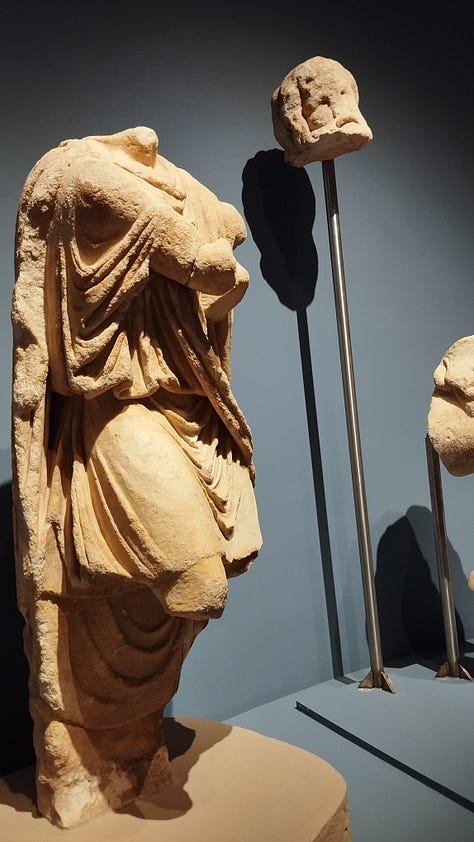
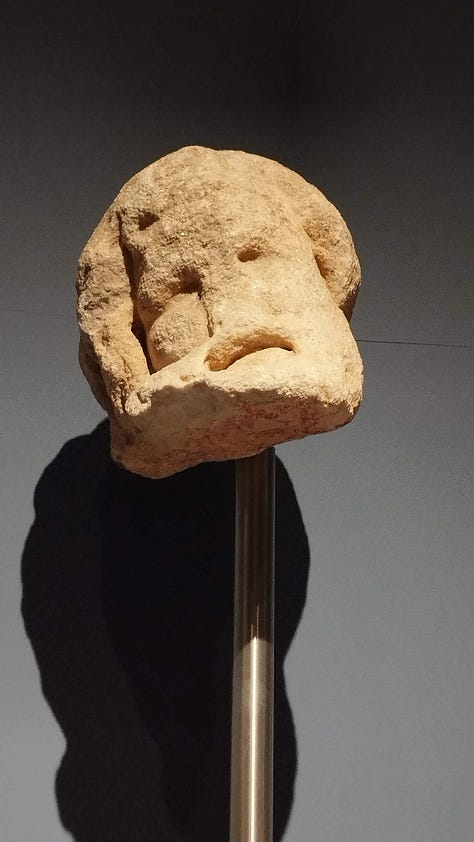
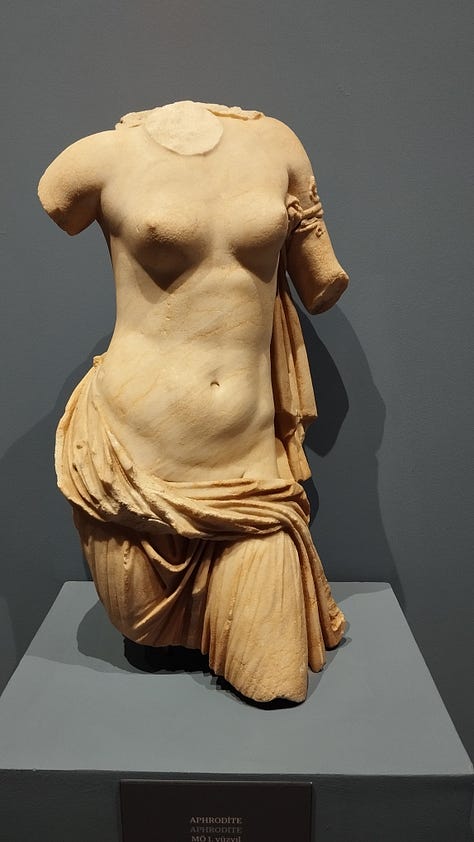
For me, personally, these statues don’t make a lot of sense outside of their original settings. A tour of the city of Ephesus takes one to many fountains with blank, marble backgrounds. Those backgrounds have been moved here — for preservation, yes — but they seem disconnected from their original purpose. They seem less amazing removed from their places in the city.
Gallery 2: Artifacts from the Terrace Houses
When I tour ancient sites, I often wonder how real people lived among these temples and theaters. Ephesus has a wonderful area of apartment-villas that one can tour known as the Terrace Houses. A tour of these houses sees painted walls, amazing mosaics, and evidence of the indoor plumbing that offered modern comforts in this ancient city.
This gallery includes a timeline of the terrace houses, which doubles as a history of the city: from its rise as a Greek colony to the Roman Empire’s 4th-larges city, then its fell into ruin in the 2nd and 3rd centuries of the Christian Era, wracked by invasions, earthquakes, and the silting of the harbor.
This room is filled with luxuries, as the terrace must have been prime real estate in Ephesus. Perfume bottles, toys, and statutes are on display. There are busts of famous Romans (marble heads of Romes first emperor and empress, Augustus and Livia, were found in Ephesus but are on loan to a museum in Istanbul).
There is a statue of Artemis in this room, far different from the statues of the goddess in the Artemis Gallery. I recently learned of the discovery of this statue from a post about this picture:
This seems astonishing. Imagine tearing away centuries of rubble to find Artemis standing there, waiting for resurrection! This photo also illustrates the actual terrace houses, made of flat, Roman bricks, and featuring painted images such as the one to the left of the statue here.
I should emphasize that this Artemis, with a bow and short skirt, is the Greek Artemis, who was a goddess of the hunt. The Ephesian Artemis was a fertility goddess and was displayed in a very different costume, as we see later in the exhibit.
Another artifact that caught my attention on this visit was an exquisitely carved ivory frieze which showed Roman emperor, Trajan, setting off with his troops for battle with Parthians. Dozens of soldiers and onlookers are carved in fine detail as they march around the sides.
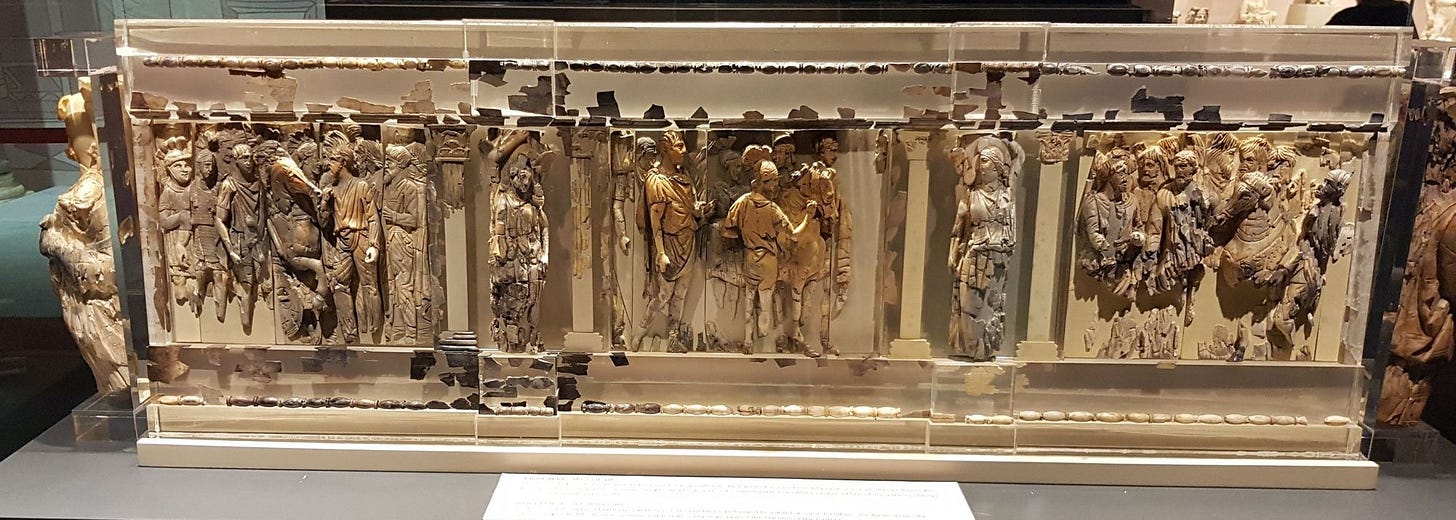
The terrace houses room is one of my favorites in the museum. Only Artemis holds me more spellbound than this gallery.
Gallery 3: The Coin and Artifact Gallery
Most museums in Turkey have coin collections, and the Ephesus Museum is no different. I always enjoy looking at the illustrations on the coins — which stretch from ancient times through the Ottoman Era, and which aren’t limited to Ephesus but also feature coins from surrounding cities.
There are also a few “hoards” of coins from finds in the area. These are collections of scores of coins that had been buried. The coins are displayed together, next to the container in which they were buried. Consider the history of Ephesus: the wars that it saw and invasions it sustained. It wouldn’t surprise me if there aren’t still hundreds of such hoards buried in the area by those who fled their homes … and never made it back.
The main part of this gallery is a series of exhibits, arranged in chronological order, showing artifacts from the centuries of Ephesian history. These are my favorite types of displays, making it easier to understand the progression of art and technology. As a Christian, I was hoping to find early artifacts from Christianity, which was established in Ephesus around 50 CE. But I didn’t see any crosses or other Christian symbols until the 3rd-century exhibit.
Outside the artifact gallery, the tour enters an outdoor courtyard, lined with sarcophagi and column capitals. It’s a nice, open space to catch one’s breath, while studying the images on the sarcophagi to imagine which details Romans wanted to be remembered by.
Here’s a video I shot of a remarkable ionic column that featured bull’s heads. It gives a sense of the courtyard around it.
Gallery 4: The Artemis Gallery
Before there was a huge, Roman city in Ephesus, the area was a “must-see” for ancient travelers because of its immense Temple of Artemis. It was the greatest temple of its day. Now it is an utter ruin, with one wobbly column, some foundation stones, and rubble lying around. Most of its marble was repurposed into buildings nearby like St. John’s Basilica and Isa Bey Mosque. Many of its columns were sent to Constantinople, where they can be seen today in the Hagia Sophia.
The beauty of the Ephesus Museum’s gallery is that it fills in the blanks to illustrate this amazing place. At the center of the gallery likes a detailed model of the temple as it appeared in its heyday. Here’s a video I posted on my Instagram,
<blockquote class="instagram-media" data-instgrm-captioned data-instgrm-permalink="In panels around the model temple lie artifacts of the mother goddess from the temple site, showing the development of her image over the centuries.
In a second room of the Artemis Gallery are two statues of the goddess, similar to what would have stood in the open-air temple court. The sacred room at the back of the temple, the cella, was a treasure chamber where offerings to the goddess were stored.
When the city of Ephesus was excavated, archaeologists found two idols buried under the pavement of Karetes Street, the main boulevard that stretches from the South Entrance to the Library of Celsus. One idol bore a towering headdress with an image of the temple at the top. She is known as “Great Artemis” (büyük Artemis in Turkish).
The other idol did not have a headdress, and her face is less damaged. She is known as “Little Artemis,” but I tend to think of her as cute because of her Turkish name, küçük Artemis. I did notice on this visit that the top of her head is flat, and it looks like she, too, wore a headdress when she was the mother goddess of Ephesus.
Both were wearing the same, elaborate robe, covered with gryphons and flower garlands and featuring an array of hanging sacs around the bodice. At the yearly Artemis Festival on her birthday, May 6, the idol would be carried out of the temple, about 3 km outside the city, and carried to the gates, where it was paraded and celebrated with feasts and games.
This Artemesia parade ended as Christianity took hold, but May 6 became the feast day for St. John, the first Christian bishop of Ephesus, so the feasts continued. And the veneration of a holy mother continues as well, as pilgrims flock to worship at a site atop a hill near Ephesus believed to be the final home of Mary, the mother of Jesus. (There is no mention of Mary in the museum.)
Gallery 5: Roman Emperors
Upon entering the final room of the museum, one sees the immense baby face of the Emperior Domitian (ruled 81-96 CE) looking at a raised fist, all that remains of his temple near the city’s agora. Ephesus completed with other cities in the Empire for imperials honors. One way to gain recognition was to build temples for the emperor, which gave them favored status or neokros. It is similar to the way that American cities might strive to get a football or baseball franchise by building publicly funded temples of sport for the teams’ billionaire owners.
This final gallery is filled with statues from these memorials. The cult of the emperor was a two-edged sword. For while Ephesus, at its height, claimed to be “four-times neokros,” it had to rename several of its imperial temples when its honored emperors were de-deified after their deaths.
The exhibition ends in a small gift shop. There is also a nice Roman-style courtyard there, where I sat and wrote in my diary before heading back into the February cold of the Izmir region.



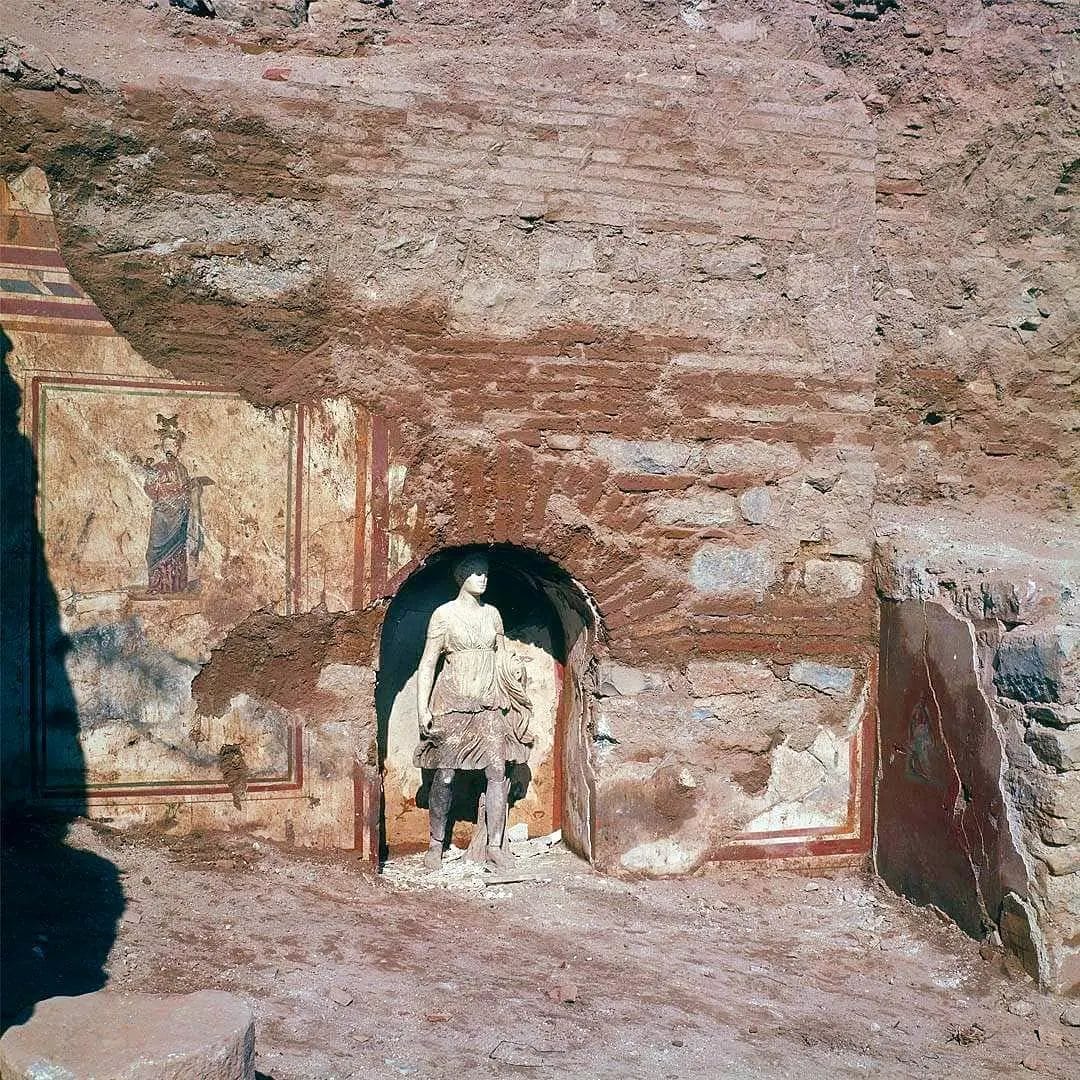

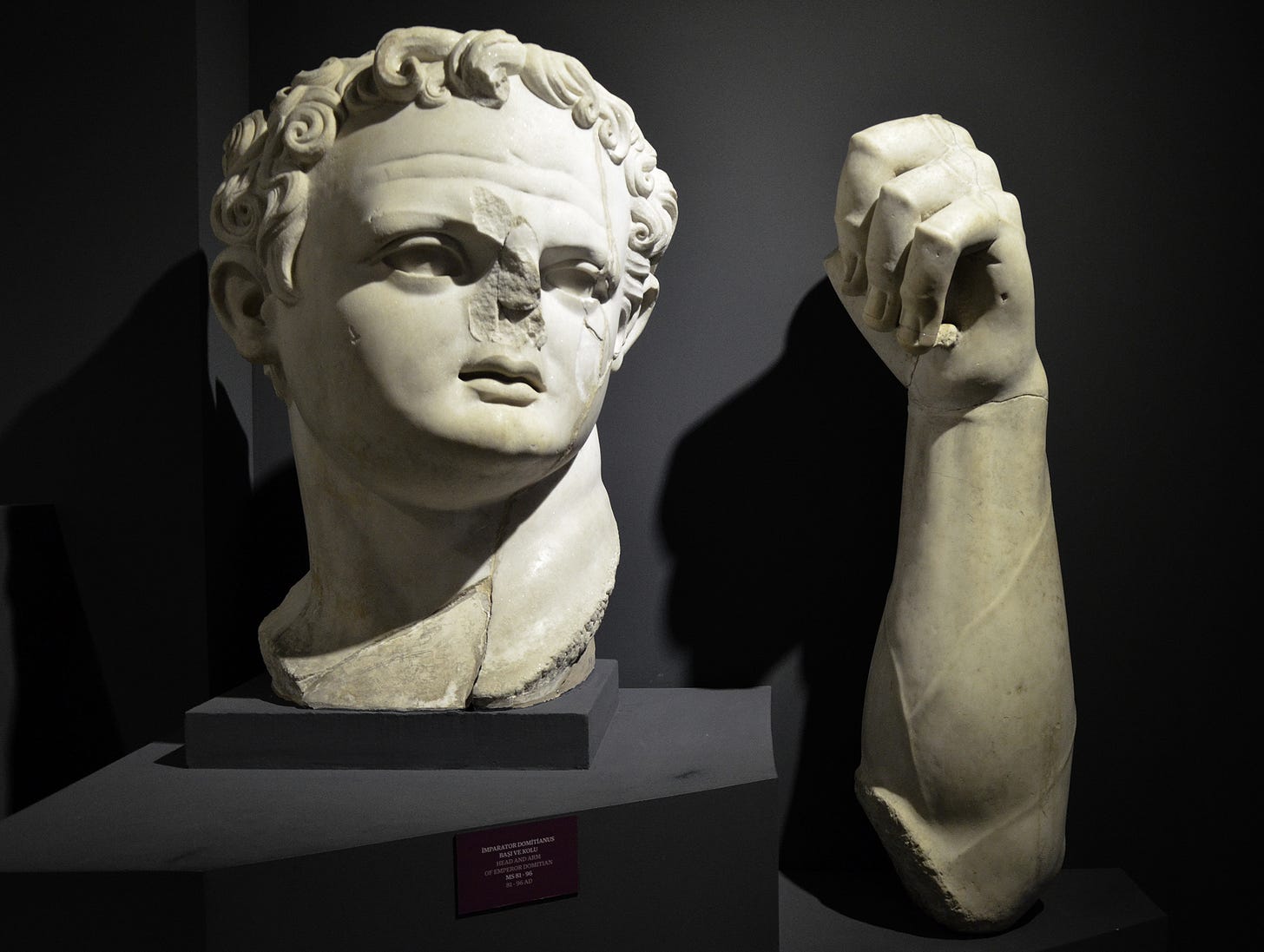
I seem to remember the luxurious living quarters on the Ephesus hillside. It's sad that the 4th largest city in the Roman empire had to go down to ruins, but the museum has recaptured some of its splendor. I wish they would have honored John the Beloved there. He did serve as the Bishop of Ephesus. Perhaps a Christian should run for Mayor of that great city.